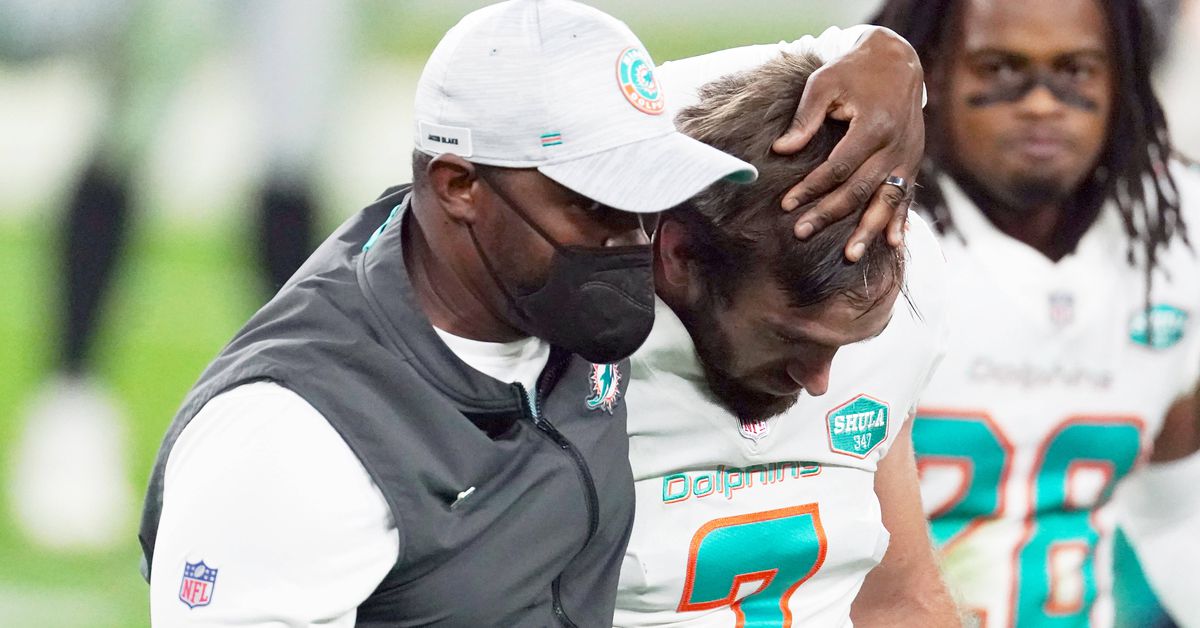Team building is certainly a tricky thing. At least for the Dolphins it has been. The two main parts of team building are the draft and free agency. In my years of observing this league and sports in general, it seems most teams and its fans are hellbent on going one way or the other.
We see all the time how teams need go 0-16 or 1-15 in order to get the first pick to select the best player of the draft. However, when you think just a bit more critically, more times than not teams will need to do a bit more in order to build a good team.
Then there is the other method of trying to build a contending team. You see teams like the Raiders, Bears, Cowboys, and several others sign 30-something year old free agents whose name you would recognize. But does that actually help? For a long time Dolphins Owner Stephen Ross thought that was the way to go. The results yielded a decade of the Dolphins winning anywhere between six games and 10 games. Only two playoff appearances and no playoff wins.
However, things finally changed at the conclusion of the 2018-2019 regular season. The Miami Dolphins finished 7-9 and missed the post-season. Adam Gase was fired. Mike Tannenbaum was fired. Chris Grier–remaining as the General Manager–was given full control of the teams roster and made all football decisions for the team.
Nearing the end of his second legitimate season as the teams architect the Dolphins have the second youngest team in the league, are the 5th seed at 10-5, and could own a Top-3 pick thanks to the biggest robbery of this century. So, how did we get here? And is this model easily replicable?
Honest Evaluation
The main thing that drew a lot of the “tanking” talk was how Miami was dumping their veteran players. Players you knew, but weren’t really producing. Names like Andre Branch, Robert Quinn, TJ McDonald, Akeem Spence, Ja’Wuan James, Brice Butler, among several others. Then you have guys like Frank Gore and Cameron Wake who are passed their prime and were only getting worse. Finally, the ever so controversial Ryan Tannehill. Clearly seemed burnt out in the final games of the season where the criticism was at an all time high. So, in order to enter a new era they pushed out the old names and had one of the youngest rosters in the league.
Then there was the Minkah Fitzpatrick and Larmey Tunsil trades. What seemed to be the capper for the tanking talks, but in reality it was more about honest evaluation of the teams stance. Because even though Fitzpatrick and Tunsil were very young and very good, they weren’t going to push Miami to the playoffs. The team had to be honest and make the decision that helps the team long-term. Keeping a disgruntled safety and having to pay $22 million a year for a tackle or gain three first round picks, a future second, and a few other picks/players. Either way you’re not making the playoffs. The decision was not hard.
Draft Capital
First, they didn’t want to trade either one of these players are both were still young and obviously had been very good the season prior. However, Fitzpatrick had demanded a trade. The Dolphins brain trust spent the next week trying to convince Minkah to reconsider and after the New England game he had seemed to make his final decision.
As for the Larmey, they very clearly valued him as they were asking for either two first round picks or one first round pick and Jadeveon Clowney, as well as a future second round pick. They never thought they would get the Texans to offer that kind of trade, but they did. As much as I love Larmey and despite how angry I was at the time he was traded, it was the right move for the Dolphins.
Since then they have drafted Austin Jackson, due to the Fitzpatrick trade. Now they have Noah Igbinoghene and currently own the third pick because of the Larmey trade. Which they can use or they can trade down and gain more capital.
Besides the uber-talented young players Miami has been able to find trade value in players you would think weren’t worth trading for. Because of that they have had one of the most stacked draft capitals in the history of the league. Especially in the first two rounds.
Cap Space and Contract Construction
Another thing that led the Dolphins purging their roster was inflated contracts that were back-loaded when they were signed. In the past, there has always been an issue when Miami was constantly low in cap space and it was really hard to fill the needs that they had because they didn’t have a lot of picks either. That led to some tough decisions which included restructuring several players contracts, digging them in a bigger hole for future cap. If they couldn’t do that they would just cut the player or not resign him. It was constantly one step forward, one step back.

The main thing that Chris Grier has done as the only decision-maker for the team has been staying ahead of the cap. This includes resigning players before their contracts expire, preventing them from entering free agency and having their market value rise exponentially. In addition, creating a lot of cap space gives the team the chance to front-load all of their contracts with their free agent signings. That way the players get most of their money sooner rather than later, and it keeps the door open for possible improvements because players won’t make as much money down the road.
More and more teams seem to be doing this. As well as keeping most contracts on the shorter side, allowing both parties to have an option on whether being together for the long-term is a good decision or not.
Coaching and Player Development
A lot of people thought Miami winning five out of their last nine was a mistake because they fell from first to fifth in the draft after starting 0-7. However, the reason why they won five out of nine then is a big reason why they are 10-5 now. Good coaching and player development.

Most people see a meaningless win against any of the teams they beat. What I see is a culmination of improvements across the board. Eric Rowe being moved to Safety and becoming one of the best Tight End stoppers in the league when originally he was a terrible corner. Bobby McCain going from an ok slot Corner to a pretty good deep Safety. Nik Needham going from a guy who I was begging to be cut for most of the season to being a good slot Corner. Mike Gesicki who was a bunch of nothing turned into one of the most improved tight ends in the league. DeVante Parker finally having his breakout season.
When you see all these players getting better with each passing week it is worth sacrificing four spots in the draft. Because whichever QB Miami was going to take would have been in good hands.
Obviously there is a stigma that if you sacrifice your chance to get the top player you’re seen as an idiot. However, just because someone is considered the best player at their position entering the draft doesn’t mean they will be the best at their position (compared to players from the same draft class) two years from now. That 100% depends on their health and the type of coaching each player receives.
If coaches can’t get the rest of the team to improve on a weekly basis, there is no reason to believe they can with a new QB. They don’t draft a QB and magically get good at player development.
Culture
To a lot of people, they don’t really understand or care for this term. However, it does exist and it is important for teams who might not have top-tier talent across the board.

Good culture is usually a multitude of things. It could be coaches who set the precedent that the best players play. No matter the players salary or draft status. Players who give their best no matter how good or bad things look. Players who care more about the team winning than their own personal success. As a Dolphins fan I have seen my team pack it in for the final few weeks on several occasions. I have seen my coaches not play the best players. I have seen players who care more about their personal success than team success.
Every player will say they care more about team success more than their personal success. Every coach will say the best players will play. But actions speak louder than words and you can certainly distinguish those who mean what they say and those who don’t.
Free Agency
The last two segments play heavily into top free agent decisions. Do some top free agents go to the highest bidder? Sure. But most players want to have a chance to win.
With that being said, on more than one occasion I have seen people say “Team X could be a top destination for free agents because they have–or could have–the first pick, a lot of cap space, and a new head coach”.

Yet, I never see top free agents go to those places. Last time I checked Kevin Durant and Kyrie Irving went to the Nets and not the Knicks. Last time I checked Byron Jones and Kyle Van Noy went to the Dolphins and not the Bengals. The two teams who have been praised for their great culture and young nucleus got the top free agents while the really bad teams stayed really bad except they got a top prospect.
Top free agents didn’t care about Joe Burrow. Top free agents didn’t care about Zion Williamson or RJ Barrett. Which has me believe that top free agents won’t care about Trevor Lawrence.
I’m not saying the draft isn’t important, but fans and spectators need to calibrate with this obsession that the only thing that matters is getting top picks. Because teams rarely hit on all their draft picks, so they need to get a good mix of free agents–who are closer to being known quantities–in order to build up. And when you’re constantly picking in the Top-10 and only winning 2-5 games, then you can say goodbye on any chance a good player will sign with you.
Conclusion
So, is this easy to replicate? No, because hitting on draft picks and free agents is never a guarantee. Hiring a good coach obviously isn’t a guarantee. Getting ownership and people in the front office to be truly honest with where their teams stands almost never happens. Too many teams lean heavily on either the draft or free agency. Never getting a good mix of both.
However, the blueprint seems to be out. Hire a coach whose strengths are setting a good culture and player development. Purge your roster now to open opportunities later. Build your draft capital.
Teams will try to copycat this blueprint. Some have already started, but there is a reason why a good majority of fans and spectators believe the Dolphins will be around for a long time. It’s not because what they have done is easy to replicate.




